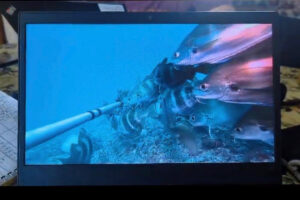Initial results from 2023 survey confirm fishermen’s reports of increasing abundance
Last week saw the 15th annual survey of the Lyme Bay MPA, alongside a Consultative Committee meeting attended by representatives from the Lyme Bay Fisherman’s CIC, fishermen from Lyme Regis, Beer, Axmouth and West Bay, and representatives from Natural England, Dorset Wildlife Trust, the MMO, Devon and Severn IFCA, Southern IFCA, the Blue Marine Foundation, Dorset Council and the University of Plymouth.
Areas of Lyme Bay were closed to mobile gear back in 2008, after a vocal local campaign to shut larger areas of the bay, citing claims of damage to the fragile habitats and species such as sea fans. Rather than introducing a blanket ban on fishing, a groundbreaking initiative saw the introduction of VMS and a smaller patchwork of closed areas that allowed commercial fishing to continue in large areas of the bay.

An image from the laptop in the wheelhouse of Rob King’s vessel Blue Turtle, with footage from the baited cameras deployed during the ongoing survey in and around the Lyme Bay reserve. (Photo: Amy Cartwright)
This year’s survey, operating a baited remote underwater video system (BRUVS), followed protocols developed 15 years ago, surveying areas within the reserve itself, and comparing the results to similar surveys in areas where mobile gears are continuing to fish.
This summer’s survey is being undertaken by the local fishing vessel Blue Turtle, operated by Rob King, a member of the recently formed Lyme Bay Fisherman’s CIC (Fishing News, 23 February, ‘New Lyme Bay Fisherman’s CIC: a community focus others could follow’).
“I am really proud to be involved in the work with University of Plymouth monitoring the Lyme Bay reserve,” Rob King said. “As a charter boat skipper doing recreational angling trips as well as a commercial fisherman, it’s been really exciting to see how the marine life is thriving in the protected area – the diversity is evident on the cameras.
“Over the years I have been involved, what we see on the cameras is backed up by catches, whether that’s when recreationally fishing or when I’m netting.”
Amy Cartwright from the University of Plymouth, who has been leading the data collection onboard the vessel, said: “We use BRUVS and a towed video array to determine the overall abundance and diversity of marine species in the MPA. Comparing this to nearby areas still open to towed fishing, this can then be used as a measure of recovery. We’re also investigating data from key indicator species such as king scallops and pink sea fans.
“Overall ecological recovery trends are positive, with abundance and diversity generally higher in the MPA than open control areas. Notably, the seabed in the closed areas recovered quicker after the severe winter storms of 2013-14 compared to areas still open to towed fishing gear.”
The survey, involving hundreds of hours of film footage that then requires analysis, will contribute to the annual report. Initial results from the first days of the survey have confirmed fishermen’s own catches, with further increase in abundance of congers in the bay being notable.
The Consultative Committee meeting, held last Wednesday (28 June), focused on the proposed amendments to the Lyme Bay Reserve Project memorandum of understanding and terms of reference, and also included updates from all attendees.
This story was taken from the latest issue of Fishing News. For more up-to-date and in-depth reports on the UK and Irish commercial fishing sector, subscribe to Fishing News here or buy the latest single issue for just £3.30 here.
Sign up to Fishing News’ FREE e-newsletter here.








